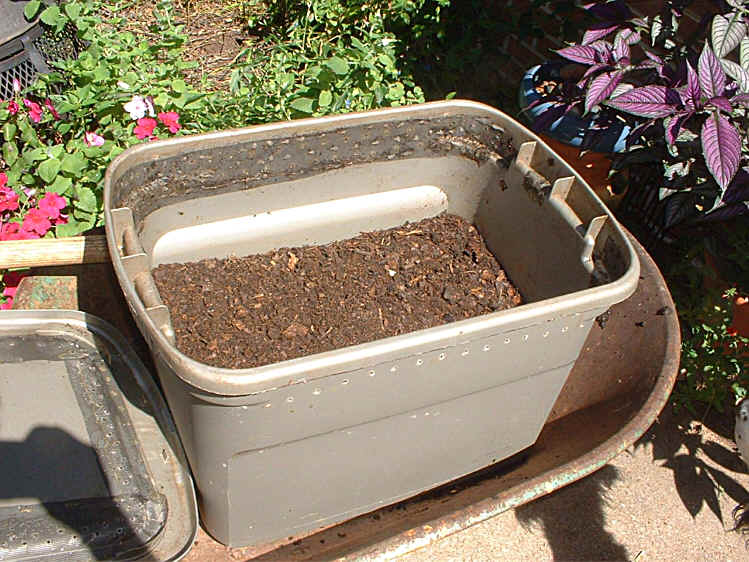
© 2007 by Man of the Cloth Productions
This is how I recycle kitchen waste with a red worm vermiculture system. It is simple, it makes great compost, and it really works.
To begin, I drilled holes around the top edge of a plastic tub. I did the same with the lid and placed a few holes in bottom. Using a hot glue gun I glued plastic window screen material over these holes.

To provide a bed for the worms I tore newspapers into strips and placed these pieces in the bottom. The bed was about 6-8 inches deep. I sprayed these strips with water until they were moist but not soaked into a wet blob. Worms need moisture and air to live.
A starting ratio of worms to food waste should be: for one pound per day of food waste, use two pounds of worms (roughly 2000). If you are unable to get this many worms to start with, reduce the amount of food waste accordingly while the population steadily increases. I order my red worms (Eisenia foetida commonly known as red wigglers or manure worms) from http://www.wormman.com/pd_red.cfm. These are not what are commonly called earthworms or night crawlers. A close up follows:

My red worms arrived alive and well a few weeks later in the mail. I added the worms along with the shipping material to the moist newspaper bed. On top of the worms I placed lettuce leaves, peals and scraps from potatoes, carrots, apples, beans bananas, etc. That was it.
Every day I added any raw fruit or vegetable waste to the top surface of my worm bin. I never added left-over scraps from the table to the bin. I kept all meat, milk, butter, oil, salt and spices out of the bin. These items cause odor and could kill the worms.

I kept my worm bin in the
basement, since it is constant in temperature, even in humidity and
dark. Worm don't like to be disturbed.
Once in a while I would gently move the bedding aside to see that the
worms were OK and to visually check on the moisture in the bedding
material. If it was drying out I would sprinkle a little water into
the bin. Most of the moisture needed to keep the bedding environment
healthy came from the organic material I added.
After a year I carried the bin outside and sorted through the bed. I set aside each worm that I found, placing it into a small pile of potting soil. I placed the worm castings and composted organic material into buckets. The photo above shows the yield . The compost from the worm bin is ready for potted plants or the garden. It can also be used to make a fertilizer "tea." It is odorless and contains a rich balance of nutrients for plants.

In the year that passed, I had an outdoor compost pile. I added leaves, grass and garden waste to this pile. After a year it yielded a wonderful, light compost. For my second round of worm composting I decided to use the leaf compost as the bedding material for the worms. I heard that worms like it better. In fact, worms naturally came to inhabit the outdoor compost pile. I expect ever greater success using this material.

This photo shows some of my worms on the surface of the new worm bed after I added them to start my second "crop" of compost.

Here is a view of the lid of the bin. The holes provide air circulation and keep the moisture in the bin from building up too much.
Using a worm bin is not time intensive, it reduces my curb garbage, saves me money, uses no electricity, and provides free, odorless compost filled with clean rich worm castings. What a simple way to be a steward of the earth.
Happy composting.
Worms Eat My Garbage: How to Set Up & Maintain a Worm Composting System by Mary Appelhof is a great book that goes into more detail. Check your library or Amazon.com.
Worm
Book - The Complete Guide to Gardening and Composting with Worms
Worms are the latest (as well as, of course, perhaps
the oldest!) trend in earth-friendly gardening, and in this handy guide, the
authors of Dead Snails Leave No Trails demystify the world of worm wrangling,
with everything you need to know to build your own worm bin, make your garden
worm-friendly, pamper your soil, and much much more.
http://www.vermicoast.com/
Shelley Grossman and Toby Weitzel, Master Composters in
Carlsbad, California, have produced a book and video, linking vermicomposting
with an emphasis upon recycling. The book, Recycle With Earthworms: the Red
Wiggler Connection, discusses earthworm biology as well as construction and
maintenance of worm bins. And from beginning to end the concern for waste
reduction is evident.
The
Earth Moved: On the Remarkable Achievements of Earthworms
In the tradition of the bestselling The Botany of
Desire comes this fascinating exploration of the underground world and one
of its most amazing denizens. The earthworm may be small, spineless, and blind,
but its role in the ecosystem is profound. It tills the soil, destroys
microscopic organisms that cause plant disease, breaks down toxins, and turns
the ground into rich compost, creating the most fertile areas on earth.
www.recycledorganics.com The publication Best Practice Guideline to Managing On-site Vermiculture Technologies is freely available on-line from this link. This "how to" guideline is based on applied research and development rather than regurgitated myth, has been produced with regard to the real world realities of on-site and commercial scale vermiculture operations, and has been reviewed by commercial vermiculture practitioners.
Cityworm Picture yourself after dinner. It has been a hard demanding day in the City. But now you can descend into the dark...touching the rich, dark vermicompost, releasing the memory-filled odor of damp earth---taking you into forests and the prehistoric past.
The Worm Digest is an excellent publication for the worm enthusiast.

My Folding Boat - The Barquito